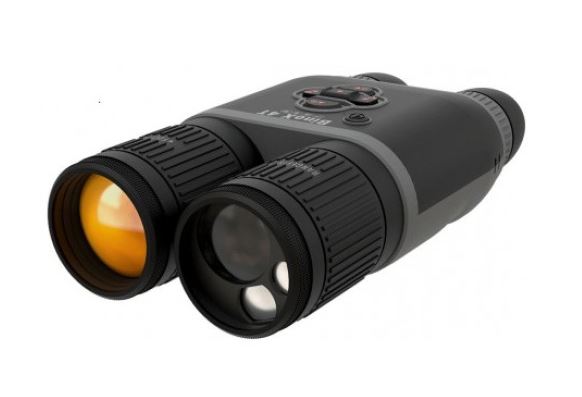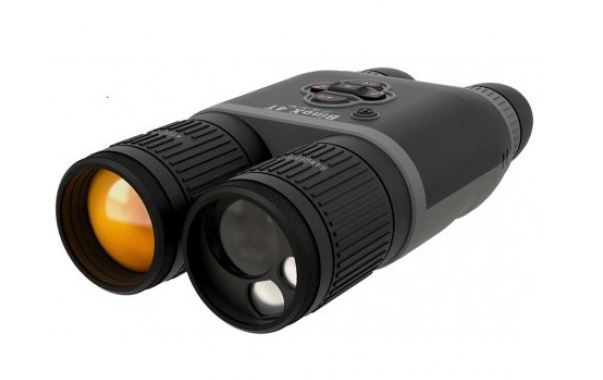Products:
Focusing the Reticle
There are two user-adjustable optical settings on Nightforce® ATACR™ riflescopes: the reticle focus and the parallax adjustment. The reticle focus is used for setting the reticle focus to match your particular vision. It should not be used to try to focus for parallax. If you plan to wear vision correction when shooting, then set this focus while wearing your corrective lenses. The reticle focus should be set before setting the parallax adjustment. If the reticle focus is inadvertently set to the extreme ends of travel it can adversely effect parallax. Record the number of turns you have made on the eyepiece from the original factory setting so you can return to it if needed.
Note: All Nightforce riflescopes are factory set for average eye strength, so this adjustment may not be necessary.
Reticle Focus Adjustment
Grasp the eyepiece with one hand and the locking ring with the other and rotate the eyepiece counter-clockwise, turning it away from the lock-ring while holding the lock-ring, power zoom ring and the riflescope to keep them from turning with the eyepiece. Several turns of the eyepiece may be necessary to achieve any measurable difference. To achieve an out-of-focus starting point
for your vision, you may need to turn the lock-ring several turns inward first, then turn the eyepiece inward as needed to achieve an out-offocus position.
- Set the power zoom ring at the highest magnification.
- On riflescopes with parallax adjustment, set it to the infinity setting ∞.
- Look through the riflescope eyepiece at a light colored background such as a white wall, overcast sky, or drape a thin white cloth over the objective to eliminate background clutter. Determine if the reticle is clear and in focus instantly when you look through the eyepiece. Be aware that staring at the reticle for more than two seconds during this process will cause your
eye to compensate, resulting in a false indication of reticle focus. Look away for a few seconds then retry for best results. You are looking for a sharp, crisp and well defined reticle image. - If adjustment is necessary, follow the steps outlined here. Due to the way the human eye focuses, best results are usually obtained by turning the eyepiece inward until the reticle is slightly blurred then moving it outward until sharp focus is obtained. Refer to Figure 1.

WARNING!
To avoid permanent eye damage or blindness, do not look directly at the sun or other extremely bright lights through the riflescope.
Once the desired reticle focus is achieved, lock the eyepiece in place by turning the lock-ring into firm contact with the eyepiece while holding the eyepiece in position. Tighten the lock ring against the eyepiece so that the eyepiece, lock ring and power zoom ring move as a single unit. If the reticle tends to fade in and out of focus, or you are experiencing eye strain with extended shooting sessions, that is an indicator that the reticle is not properly focused for your eye.
Parallax Adjustment
Nightforce® ATACR™ riflescopes have parallax adjustment mechanisms.Parallax is the apparent movement of the reticle in relation to the target as the shooter moves his eye across the exit pupil of the riflescope. This condition is caused by the target and the reticle appearing on different focal planes within a riflescope. At longer distances, and higher magnification settings, significant sighting error can result if parallax is not removed. For best results we recommend checking for parallax, and removing if necessary, at each change in target distance.

Checking for and removing parallax
While keeping the rifle stable and looking through the riflescope at a specific point of aim on your target, a nod of the head up and down will quickly determine if parallax is present. When parallax exists, the reticle will appear to move even though the riflescope is stationary as the head is nodded up and down. To remove parallax, adjust the parallax adjustment mechanism until the
reticle remains stationary in relation to the target regardless of head movement.
Note: Yardage/meter markings are included on select Nightforce riflescopes.
These markings are approximate values as a guideline to begin adjusting parallax. These markings are not intended to be used for ranging purposes.
DigIllum™ Reticle Illumination
The Nightforce® ATACR™ 7-35 x 56 F1 features DigIllum™ digital illumination, including both red and green options. Reticle illumination is controlled by the sand-colored push button located in the center of the parallax adjustment. See Figure 3.
Turning the illumination on and off
To turn on your DigIllum™ illuminated reticle, simply press and release the illumination control located on the center of the side parallax adjustment. The reticle will illuminate to the last used intensity and color setting. To turn your DigIllum™ illuminated reticle off, press and hold the illumination control for 1-3 seconds and release.
Adjusting illumination intensity (brightness)
Once turned on, by repeatedly pressing and releasing the illumination control you will change the intensity of the reticle. There are multiple intensity levels in the standard illumination mode. When the illumination reaches its minimum or maximum intensity, the reticle will flash three times. After reaching the minimum or maximum intensity, continuously pressing and releasing the illumination control will either increase or decrease the intensity away from the respective setting.
Selecting the reticle color
The DigIllum™ illuminated reticle allows the user to choose between red or green reticle illumination. By pressing the illumination control for about five seconds, the color will change from red to green or green to red.
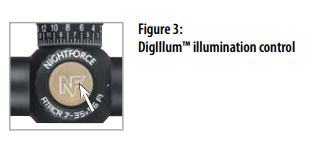
Battery Replacement
The battery is held underneath the adjustment cover, which is removed by turning the knurled portion of the adjustment cover counterclockwise until the cover comes off. See Figure 4. With DigIllum™ reticle illumination, your battery can produce 29 hours of continuous use at maximum illumination and up to 140 hours at its lowest intensity. Replace depleted batteries with an Energizer® CR2032 or equivalent. Install the battery with the positive (+) side up. Don’t forget to turn off the illumination when not in use to prevent depletion of the battery. An auto-shutoff will turn off illumination after one hour of no activity.
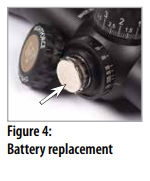
WARNING!
Make sure that your rifle is unloaded prior to installing any Nightforce® riflescope or accessory. Recheck the chamber if you stop the procedure and resume later.
Installing the Riflescope
FAILURE TO PROPERLY INSTALL THE RIFLESCOPE MAY CAUSE EQUIPMENT AND/OR PERSONAL DAMAGE WHICH CAN RESULT IN EQUIPMENT FAILURE, SERIOUS INJURY OR DEATH.
Note: Please take time to record your serial number on the inside front cover of this booklet. It can then be easily referenced for your online warranty registration. Once the scope has been installed, you may not be able to read the serial number, as your rings/mounts may cover it.
Nightforce Torque Specifications for Standard and X-Treme™ Duty Rings, Bases and Mounts
- Base and Direct Mount™ attachment screws – 25 inch pounds
- Ring top screws – 25 inch pounds
- Ring crossbolt nut – 4-screw design, 68 inch pounds; 6-screw design, 100 inch pounds
- Unimount™, Extended Unimount™ and MagMount™ crossbolt nut – 68 inch pounds
WARNING!
With hard-recoiling rifles, serious injury or even death can result from eyepiece impact with the shooter during the recoil process when discharging the firearm. Be certain that your installation provides sufficient eye relief for the recoil generated by your rifle before shooting the firearm.
NOTE: Give special attention to this warning when shooting uphill and/or from a prone position. These shooting conditions can dramatically reduce eye relief. PLEASE maintain maximum eye relief when shooting heavy recoiling and/or magnum firearms.
Ring and Base Selection
Your riflescope and rifle are only as good as the link between them. The mounting of your riflescope is as important as the bedding of the rifle’s action to the stock. To ensure the highest level of performance, the following steps in the mounting procedure must be followed as described.
We recommend standard or X-Treme™ Duty Nightforce® bases, along with Nightforce® 34mm rings and one-piece mounts for a solid and precise installation. Please use the following guidelines to select the proper mounting solutions for your rifle.
- A high quality ring and base combination using a 1913 Mil. Std. type rail is recommended for field use and/or high-recoil applications. Nightforce®standard and X-Treme™ Duty 34mm rings, bases, Unimount™ and MagMount™ are ideal for virtually all applications.
Mount Installation
Note: Do NOT lap the Nightforce® Unimount™, Extended Unimount™, Direct Mount™, MagMount™, Ultralite™ or Standard Duty rings. Lapping is not necessary with these Nightforce accessories. Lapping these products will void the Nightforce accessory warranty and may lead to slipping and/or crushing of the Nightforce riflescope main tube. Other manufacturer’s ring/base combinations may or may not require lapping.
Attaching the Base to the Action
Once you have determined that the base-to-action mating is acceptable, install the base to the action, torquing the mounting screws to the manufacturer’s specifications.
Attaching Rings to the Base
Clean/degrease the inside of the rings and then clean the outside of the scope tube before installing in the rings.
Install the rings on the base per the manufacturer’s specifications using the proper torque on the locking mechanism. Avoid positioning the rings where they will make contact with the adjustment assembly, the objective bell section, or the power zoom ring on the riflescope body. Apply forward pressure to the ring while tightening it in place to keep the cross bolt on the ring in firm contact with the forward surface of the cross slot in the base.
With Nightforce rings and one-piece bases you should not lap the rings. With other brands lapping may be required. If the scope lays into the rings stressfree, there is no need to lap the rings. If required, we recommend lapping be done by a qualified technician or gunsmith. Do not overlap the rings. Damage to the scope from improper lapping/installation is not covered by the warranty.
Mounting the Riflescope
- For initial fitting of the riflescope to the rifle, set the Nightforce® riflescope to the highest magnification. Place the riflescope in the lower portion of the rings as far forward as possible. Install both ring tops. Tighten ring top screws with just enough tension to hold the riflescope where positioned, while still allowing smooth movement fore and aft and rotationally.
- Hold the rifle in your normal shooting position with the riflescope positioned fully forward in the rings, preferably while adjusted to maximum magnification. Place your head as far forward on the stock as you might position it in field use. Slowly move the riflescope back just to the point where the full field of view is obtained. It is recommended to mount the riflescope at this position with as much eye relief as possible (3.5”–4”) or slightly forward to ensure maximum eye relief. (Figure 5)
Note: Please see warning on page 7 regarding sufficient eye relief. Eye relief will change with the thickness of the clothing you wear and may need to be readjusted.

Leveling the Reticle
For precision shooting, the reticle and the rifle need to be squared, or plumb, to each other. Any out-of-square condition can cause sighting errors that will be magnified even more at longer distances.
The reticle in all Nightforce® scopes is confirmed plumb with the flat surface on the bottom of the adjustment saddle. (Figure 6) You can use pin gauges, a sliding sine bar or flat shims to align the flat surface with the top of the scope rail. To level the reticle using a plumb line, follow the three steps that follow.
- Level the rifle on a steady rest such as sandbags or a stable shooting rest. This can be accomplished with a bubble level attached to the riflescope base, or on a flat section of the action.
- Use a plumb line or some other known plumb vertical line at a distancefrom the rifle where you can see it clearly through the riflescope. A distance of 100 yards is recommended, but good results can often be obtained as close as 50 yards.
- Center the reticle on the plumb line and rotate the riflescope in the rings until the vertical line of the reticle is parallel with the plumb line. Recheck the rifle level and adjust the reticle position as needed. When the rifle and the reticle is plumb, tighten all ring top screws evenly until the riflescope is secure in the rings. Recheck that the rifle has remained level and that the reticle is plumb one more time, adjust as needed, then torque the screws to the recommended torque settings. Your Nightforce riflescope is now properly mounted.
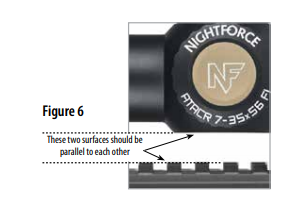
Establishing a Sight-in Zero
A quick way to get your first shot on target with a new installation is to first bore sight the riflescope. A simple yet reliable method is by looking through the bore at a round, high contrast target, approximately 5”– 6” in diameter, that can be seen clearly with the naked eye at either 25, 50 or 100 yards/meters, yet is small enough to “float” in the center of the rifle bore when viewed through the opened action. This can save you time and ammunition.
- Ensure that the rifle is unloaded and the chamber is empty. Remove the bolt and place the rifle on a steady rest.
- Looking through the bore from the action end, center the round target downrange so that it is floating in the center of the bore, then adjust the elevation and windage adjustments until the reticle is centered on the target while the target is still centered in the bore. See Figure 9.
- If you feel confident in the bore sighting, proceed to live firing at 25, 50 or 100 yards/meters. To aid in the sight-in process, be sure your sight-in target is large in size, and offers a contrasting color (i.e., white). After confirming point of impact, proceed to step four. Note: if you have sighted in at 25 yards/meters, you will need to move the adjustments four times more than you would with a 100 yard/meter sight-in. If you sighted in at 50 yards/meters, you will need to move the adjustments two times more than you would with a 100 yard/meter sight-in. If the first shot isn’t on target, recheck your bore sighting and/or move to a 25 yard/meter sight-in distance.
- Without changing the adjustments, move the rifle to center the reticle on the target. Carefully turn the windage and elevation adjustments without moving the rifle, until the reticle is aligned on the center of the bullet hole from that first shot on the target.
- Fire at least a three-shot group at the desired close-range zero distance, then fine-tune your zero as needed.
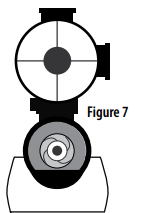
Please visit www.NightforceOptics.com for a step-by-step video tutorial on this process and advanced setting methods that can maximize the performance of your ZeroStop™-equipped Nightforce riflescope.
The ZeroStop™ elevation adjustment allows for the full use of the elevation travel above your established zero for longer target engagement distances, while still allowing for a definitive position to return to your zero, regardless of the conditions. Note: The O-rings inside the turret assembly and under the turret set screw must remain in place and must be lubricated in order to maintain the waterproof integrity of the riflescope. Take caution to ensure that this area remains free of dirt and debris. After you have determined the ammunition that performs best for your intended use and established the zero/sight-in, please follow these instructions:
- Remove elevation turret cap by loosening the two set screws 1 to 2 turns but do not remove the screw entirely. The dial should rotate freely and no adjustment “clicks” should be felt. See Figure 8.
- Lift the cap upward with a slight twisting motion to remove it from the body. You should feel slight resistance but not feel any “clicks”. Set the cap aside on a clean surface.
- You have now exposed the ZeroStop™ clutch assembly. Take care to maintain the cleanliness of the inside of the cap and the clutch area. Do not remove any of the lubricating grease. See Figure 9.
- Loosen each of the four hex screws on the ZeroStop™ clutch assembly 1 to 2 turns. DO NOT remove the screws from the clutch assembly.
- To set the ZeroStop™ clutch assembly, rotate the upper clutch face downward/clockwise until it is firmly against the lower clutch face.
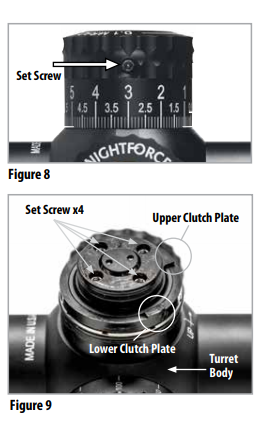

Note: You should not feel any “clicks” or resistance while making this adjustment. See Figure 10.
- While holding the clutch mechanism in position, tighten the four hex screws on the clutch assembly evenly in an “X” pattern. Do not over-tighten the screws as this can damage the clutch assembly. Tighten one screw until you feel slight resistance, then move to the next screw in the “X” pattern. Continue to do the same for all four screws. Now repeat the “X” pattern and tighten the screws to 4 inch-pounds. If no calibrated torque driver is available for 4 inch pounds, hold the short end of the hex key between your thumb and finger and turn the key approximately 1/4 turn past initial resistance until snug. See Figure 11.
- To reinstall the adjustment cap, center it over the adjustment body, and press down lightly while turning the adjustment cap clockwise until it moves into position. Keep downward pressure on the adjustment cap as it may tend to move up due to the compressed air resistance created by the O-ring seal. Align the “0” (zero) fixed index mark on the engraved scale of the adjustment cap with the center line on the scope body (Figure 8) and tighten both set screws to 4 inch-pounds.
NOTE: If no calibrated torque driver is available for 4 inch pounds, hold the short end of the hex key between your thumb and finger and turn the wrench approximately 1/4 turn past initial resistance until snug.
Setting The Windage Adjustment
The windage adjustments on ATACR™ riflescopes include a factory installed protective, screw-on cap. The windage adjustment is waterproof and can be used without the cap. A trim ring is included to protect the threads if using as an external adjustment (Figure 14).
- Remove the protective cap.
- Loosen the set screw one turn on the windage adjustment and the dial should rotate freely (Figure 12). NOTE: You should not feel any clicks when adjusting the dial at this point.
- While applying inward pressure to the dial, re-index to zero (Figure 13).
- Retighten the setscrew to four (4) inch pounds. If a torque driver is unavailable, insert the short end of the provided hex key and tighten the set screw until a slight flex in the tool is noted. See Figure 15.

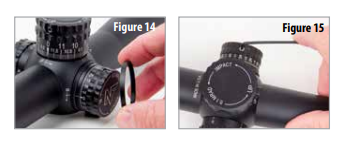
PTL™ (Power Throw Lever)
The PTL™ (Figure 16) is designed to allow rapid magnification changes, just by feel. First, ensure that your firearm is unloaded. Your riflescope arrives with a flush black insert screwed into the power zoom ring. To remove it, turn it counterclockwise with the supplied 5/64″ hex key. You can then install the PTL™ (included with your riflescope) by screwing it clockwise into the threaded hole. Tighten it securely with the hex key, but take care not to overtighten the PTL™ to avoid stripping the threads or hex hole. Keep the insert in a secure place should you wish to remove the PTL™ in the future and reinstall it.

Caring for Your Riflescope
With proper care your Nightforce® riflescope will give you many years of dependable service. Be sure to use your lens covers whenever you are not using your riflescope.
Cleaning the Riflescope Exterior
Clean the riflescope body with a clean cloth lightly moistened with clean water or alcohol. Do not use strong solvents. While cleaning your rifle, be sure to protect your riflescope’s lenses by installing the covers that came with the riflescope (or equivalent covers). Ammonia-based bore solvents can destroy the coating on the glass. Avoid spilling gun cleaning solvents anywhere on the riflescope. In the event of submersion in mud, sand, dirty or salt water, flush the outside of the riflescope with clean water to remove encrusted material and salt. If your riflescope came with screw- on adjustment covers, install them before flushing with water. Wipe the outside metal surfaces dry with a soft cloth then proceed to the step below.
Cleaning Lenses
We recommend using Nightforce® cleaning kits A130 or A431 to care for the lenses on your riflescope. These kits contain the necessary brushes, cloths and cleaning solutions to ensure proper maintenance of your riflescope. With the lens facing down to allow the debris to fall away from the surface, remove loose dirt and dust with compressed air and/or a lens brush. Do NOT use high-pressure compressed air from cans (such as found in office supply stores). They can, and have, been known to destroy lens coatings. If there is grit stuck to the lens that won’t come off with the compressed air or a brush, flushing the surface with alcohol or distilled water will prevent that grit frombeing rubbed into the glass by the cleaning swabs.
Using a soft, clean, lint-free cotton swab or lens cleaning cloth, and lens cleaning fluid applied to the swab, clean the lens starting in the center, working to the outside in a circular motion. Make only one pass to the edge where the glass meets the metal. Once you reach the edge of the lens, do not re-use that swab as it will often contain abrasive grit that will scratch the surface. Start over in the center with a new swab and repeat the process until the glass is clean. Use a very small amount of cleaning solution for thelast pass to prevent streaks.
Long Term Storage
If the riflescope will not be used for an extended period, remove the battery and store it separately. Keep the riflescope in a cool, dry, dust-free location.
For a list of frequently asked questions, video instruction, information on service and on Nightforce accessories, visit www.NightforceOptics.com.

Limited Lifetime Warranty
We are proud to back the Nightforce ATACR™, NX8, B.E.A.S.T.™, Benchrest, Competition™, NXS™ and SHV™ families of riflescopes with a transferable Limited Lifetime Warranty. The warranty covers mechanical defects in materials and workmanship in the optical and mechanical components of Nightforce riflescopes. In the event of a defect in materials or workmanship that is covered by this warranty, we will either repair the riflescope or replace it at no charge, with a comparable product at our discretion.
Exclusions to this warranty include intentional or accidental damage, abuse, misuse, unauthorized modifications or repairs, and improper mounting. This warranty does not cover any consequential or incidental damages resulting from the inability to use the riflescope. Any serial number obliteration or alteration on the product will void the warranty. SHV™ models maintain waterproof integrity with their protective caps installed.
To ensure warranty coverage, please register online or fill out completely and mail in the provided warranty card found in the back of the owner’s manual, along with a copy of the sales receipt. The warranty begins on the date the product was purchased by the original owner. The optical and mechanical components are covered without time limitations. The riflescope’s electronic components are covered for a period of three years.
This warranty gives you specific legal rights, and you may also have other rights which vary from state to state. Some states do not allow the exclusion or limitation of incidental or consequential damages, so the above limitations or exclusions may not apply to you. Some states do not allow limitations on how long an implied warranty lasts, so the above limitations may not apply to you.
Before sending a riflescope in for service, please call Nightforce Optics, Inc. at the number below, to determine if the problem can be resolved without sending us the product. All returns must be accompanied by a Return Merchandise Authorization (RMA) number. Failure to do so can result in lost merchandise and/or severely delayed service time.
- Remove any mounting rings or accessories other than dust covers and the original sunshade.
- Record and keep on hand the serial number.
- Include with the riflescope a detailed description of the defect(s), the RMA number, your name, phone number and the address you wish the riflescope returned to.
- Place the boxed or protectively wrapped riflescope in a well-padded outer box insured for replacement value and send it shipping prepaid, to the appropriate address below.
Write the RMA number on the outside of the package.
Be sure to register your warranty at www.NightforceOptics.com/WarrantyRegistration
U.S.A. & Canada:
Nightforce Optics
Attention: Service Dept.
336 Hazen Lane
Orofino, Idaho 83544
tel 208.476.9814
fax 208.476.9817
www.NightforceOptics.com
International:
Nightforce Optics
Attention: Service Dept.
11 Manton Street
Hindmarsh, SA 5007 Australia
tel +61 (0)8 8440 0888
fax +61 (0)8 8346 0504
www.NightforceOptics.com
